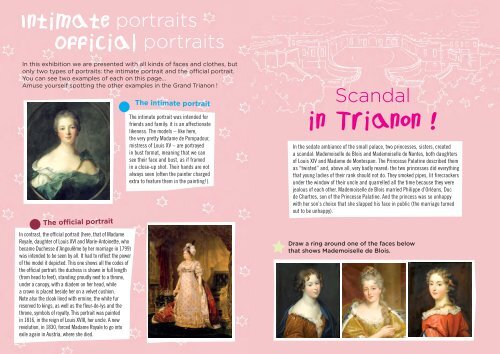download - Versailles - Château de Versailles
download - Versailles - Château de Versailles
download - Versailles - Château de Versailles
You also want an ePaper? Increase the reach of your titles
YUMPU automatically turns print PDFs into web optimized ePapers that Google loves.
Fashion and<br />
costumes<br />
Link each of the paintings<br />
to the <strong>de</strong>scription of the costume<br />
that corresponds to it !<br />
The Empire fashion<br />
(here represented by Madame Mère,<br />
the mother of Napoleon). After the<br />
Revolution, women adopted a very<br />
recognisable fashion: long straight<br />
low-necked dresses with a belt just<br />
below the breasts – thus imitating<br />
the cut of certain dresses in Antiquity.<br />
The hairstyle was also typical: rolled<br />
in a coil and with small curls on<br />
the forehead and the temples.<br />
Hunting dress<br />
✎<br />
Here, the young Duchesse <strong>de</strong> Bourgogne is shown<br />
wearing a hunting dress typical of the end of the reign<br />
of Louis XIV. It was extremely refined, with a lot of<br />
embroi<strong>de</strong>ry and lace, and a train inten<strong>de</strong>d to hang<br />
down gracefully when she was on horseback<br />
– in those days, women ro<strong>de</strong> si<strong>de</strong>-saddle.<br />
Court dress<br />
in the reign of Louis XIV<br />
The queen and the ladies in her intimate circle, like<br />
Marie-Josephe <strong>de</strong> Saxe here, had to wear what was<br />
called full court dress. It consisted of a spectacular<br />
costume in three parts: the “grand corps” (top),<br />
a sort of low-necked rigid corset with stays;<br />
the ‘”skirt” (worn over a large hooped crinoline that<br />
gave it its wi<strong>de</strong> flare, like here in this painting);<br />
and the “tail”, a long train that could be lifted up.<br />
The costume was richly embroi<strong>de</strong>red and cost<br />
a small fortune: up to 3,000 livres (ten times<br />
the annual income of a family of weavers).<br />
Widow’s dress<br />
This spectacular widow’s costume was worn exclusively<br />
by duchesses, in the time of Louis XIV: it consisted of a<br />
black velvet dress lined with ermine, with a long white<br />
holland linen veil. Here we see the dowager Duchesse<br />
<strong>de</strong> Bourbon (before marriage called Ma<strong>de</strong>moiselle <strong>de</strong><br />
Nantes: she was the daughter of Louis XIV and Madame<br />
<strong>de</strong> Montespan).<br />
The « Gaulle »<br />
dress fashion<br />
Marie-Antoinette remains famous<br />
for her coquetry and the almost<br />
extravagant luxuriance of her<br />
hairstyles and outfits. But after<br />
the birth of her first daughter,<br />
Madame Royale, she adopted<br />
a style of extraordinary simplicity<br />
for a queen: the “gaulle” (muslin)<br />
dress, a white muslin shift belted<br />
at the waist, without a corset,<br />
which allowed the body free<br />
movement, and she wore this in<br />
the privacy of the Petit Trianon.<br />
A portrait of her in this dress<br />
created a scandal in France.<br />
But we can see here that this<br />
fashion was adopted by her<br />
intimate circle – in this painting,<br />
the sister of Louis XVI, Madame<br />
Elisabeth.


